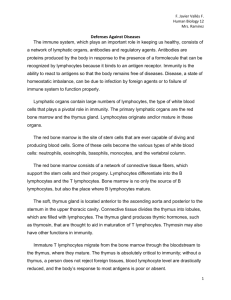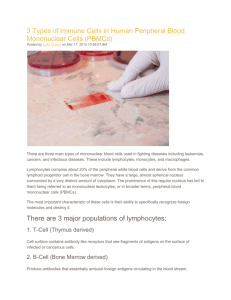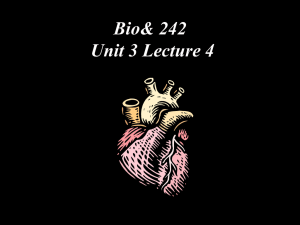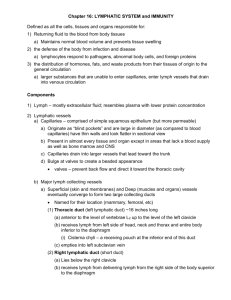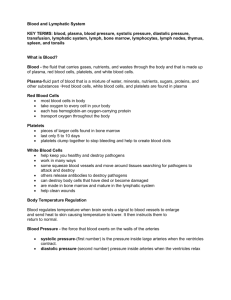Name_______________________ Mrs. Adams Anatomy II
advertisement
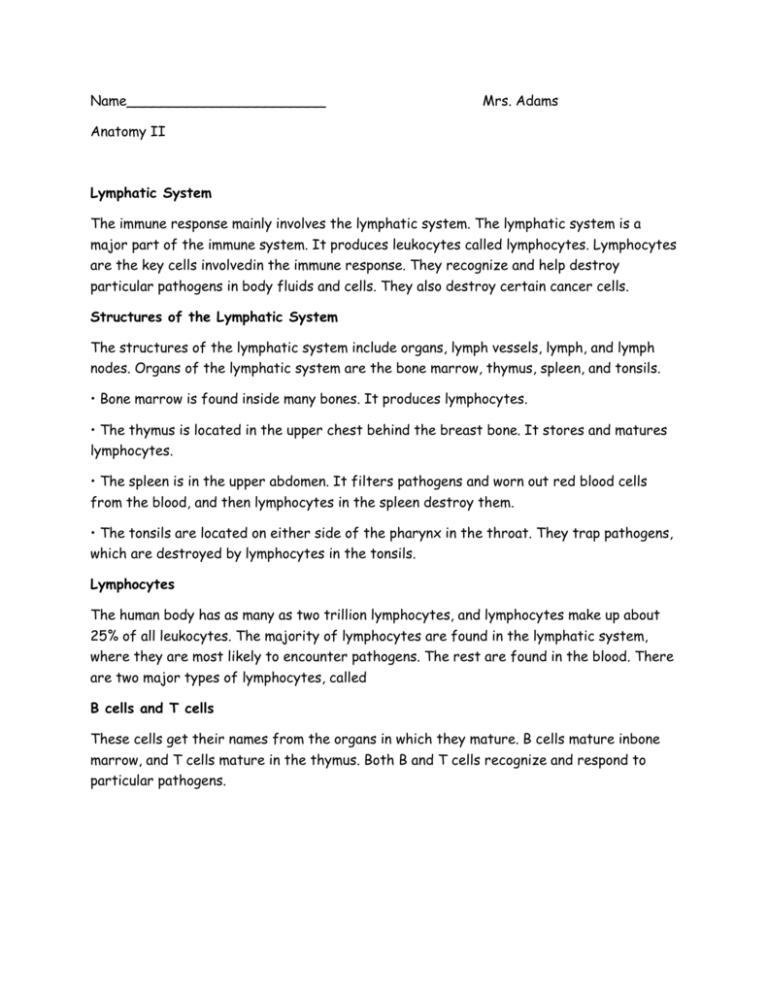
Name_______________________ Mrs. Adams Anatomy II Lymphatic System The immune response mainly involves the lymphatic system. The lymphatic system is a major part of the immune system. It produces leukocytes called lymphocytes. Lymphocytes are the key cells involvedin the immune response. They recognize and help destroy particular pathogens in body fluids and cells. They also destroy certain cancer cells. Structures of the Lymphatic System The structures of the lymphatic system include organs, lymph vessels, lymph, and lymph nodes. Organs of the lymphatic system are the bone marrow, thymus, spleen, and tonsils. • Bone marrow is found inside many bones. It produces lymphocytes. • The thymus is located in the upper chest behind the breast bone. It stores and matures lymphocytes. • The spleen is in the upper abdomen. It filters pathogens and worn out red blood cells from the blood, and then lymphocytes in the spleen destroy them. • The tonsils are located on either side of the pharynx in the throat. They trap pathogens, which are destroyed by lymphocytes in the tonsils. Lymphocytes The human body has as many as two trillion lymphocytes, and lymphocytes make up about 25% of all leukocytes. The majority of lymphocytes are found in the lymphatic system, where they are most likely to encounter pathogens. The rest are found in the blood. There are two major types of lymphocytes, called B cells and T cells These cells get their names from the organs in which they mature. B cells mature inbone marrow, and T cells mature in the thymus. Both B and T cells recognize and respond to particular pathogens. Antigen Recognition B and T cells actually recognize and respond to antigens on pathogens. Antigens are molecules that the immune system recognizes as foreign to the body. Antigens are also found on cancer cells and the cells of transplanted organs. They trigger the immune system to react against the cells that carry them. This is why a transplanted organ may be rejected by the recipient’s immune system. How do B and T cells recognize specific antigens? They have receptor molecules on their surface that bind only with particular antigens. Questions 1. What are lymphocytes? What is their function? 2. List the organs of the lymphatic system. Describe the functions of two of these organs. 3. Define B cells and T cells. 4. What are antigens? 5. How do B and T cells recognize specific antigens? Multiple Choice 1. The immune response (a) is specific to a particular pathogen. (b) is the third line of defense. (c) allows the immune system to “remember” the pathogen after the infection is over. (d) all of the above 2. The immune response mainly involves the (a) lymphatic system. (b) spleen and tonsils. (c) blood cells. (d) antibodies and lymphocytes. 3. Organs of the lymphatic system include (a) the spleen, which filters and destroys lymphocytes. (b) the thymus, which stores and matures antibodies. (c) bone marrow, which produces lymphocytes. (d) all of the above. 4. Which statement concerning lymphocytes is correct? (a) B cells mature in bone marrow, and T cells mature in the thymus, and both B and T cells recognize and respond to particular pathogens. (b) B cells mature in bone marrow, and T cells mature in the thymus, and both B and T cells recognize and respond to particular lymphocytes. (c) B cells mature in bone, and T cells mature in the thymus, and both B and T cells recognize and respond to particular pathogens. (d) B cells mature in bone, and T cells mature in the thymus, and both B and T cells recognize and respond to particular lymphocytes. 5. The humoral immune response (a) involves mainly T cells and takes place in blood and lymph. (b) involves mainly B cells and takes place in blood and lymph. (c) involves mainly antibodies and takes place in blood and lymph. (d) involves mainly antigens and takes place in blood and lymph. 6. Antibodies are (a) large, Y-shaped proteins that recognize and bind to antigens. (b) large, X-shaped proteins that recognize and bind to antigens. (c) large, Y-shaped proteins that recognize and bind to lymphocytes. (d) large, X-shaped proteins that recognize and bind to lymphocytes. 7. The cell-mediated immune response (a) involves mainly B cells and leads to the destruction of cells that are infected with lymphocytes. (b) involves mainly T cells and leads to the destruction of cells that are infected with lymphocytes. (c) involves mainly B cells and leads to the destruction of cells that are infected with viruses. (d) involves mainly T cells and leads to the destruction of cells that are infected with viruses. 8. Active immunity (a) can last a lifetime. (b) can result from an immunization. (c) results when an immune response to a pathogen produces memory cells. (d) all of the above
